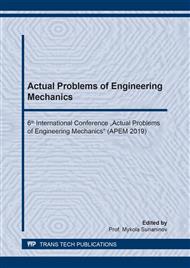p.427
p.437
p.444
p.450
p.460
p.468
p.475
p.486
p.496
The Solution of the Shells Theory Problems by the Numerical-Analytical Boundary Elements Method
Abstract:
The application of the numerical-analytical boundary elements method (NA BEM) to the calculation of shells is considered. The main problem here is due to the fact that most of the problems of statics, dynamics and stability of shells are reduced to solving an eighth-order differential equation. As a result, all analytical expressions of the NA BEM (fundamental functions, Green functions, external load vectors) turn out to be very cumbersome, and intermediate transformations are associated with eighth-order determinants. It is proposed along with the original differential equation to consider an equivalent system of equations for the unknown state vector of the shell. In this case, calculations of some analytical expressions related to high-order determinants can be avoided by using the Jacobi formula. As a result, the calculation of the determinant at an arbitrary point reduces to its calculation at the point , which leads to a significant simplification of all analytical expressions of the numerical-analytical boundary elements method. On the basis of the proposed approach, a solution is obtained of the problem of bending a long cylindrical shell under the action of an arbitrary load, the stress-strain state of which is described by an eighth-order differential equation. The results can be applied to other types of shells.
Info:
Periodical:
Pages:
460-467
Citation:
Online since:
August 2019
Authors:
Price:
Сopyright:
© 2019 Trans Tech Publications Ltd. All Rights Reserved
Share:
Citation:


